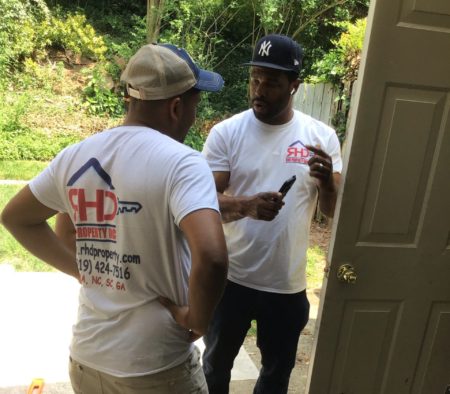The Process
The real estate construction process can be confusing on the best of days. It is even more daunting when the construction is part of a broader real estate property rehabilitation project, where things like capital and return on investment are more important than finding the exact right type of counter top.
But what’s actually involved in the construction process? What challenges should be expected? How do you prepare, as best as you can, to ensure that the construction project efforts are as painless as possible?
One of the most important steps of rehab construction, is to build a good team that includes a contractor. Of course, before construction can even get started, you will want to develop a plan of attack and create a detailed scope of work. Then, once the work begins, you’ll want to keep tabs on every stage of the project and, ultimately, do a final walk-through and deliver final payment to the contractors.
Here are our proposed steps in more detail:
Step 1: Evaluate The Property
The initial walk through of a property is one of the most important steps to success in a rehab project. When doing it on a budget, this step moves to the top of the list. Overlooking an important detail could potentially turn the project into a huge mistake.
Each property inspection with a professional inspector. These individuals will not only help to identify items that need to be repaired, but also recognize things that you might have missed. In most cases, the inspection will include examining the home’s heating and air-conditioning system, electrical system, plumbing, foundation, roof, flooring, walls, ceilings, windows, doors and insulation.
If you’re an investor, it’s important to take a combination of notes and pictures during the initial inspection. These items will play a significant role in developing a rehab checklist moving forward, as well as help investors.
Step 2: Create A Checklist
The next step is to create a rehab checklist. Outline the necessary repairs that need to be made and include the associated costs. In order to avoid missing anything, investors should incorporate their inspection report when generating a checklist. This small measure will help to produce a detailed roadmap of what needs to be done to the property.
Another factor to consider, especially for those seeking how to rehab a house on a budget, is the return on investment. Investors on a limited budget will need to examine the thin line between cost effectiveness and high returns. Some rehabs can end up costing you more than they’re worth.
Step 3: Develop A Budget
Once you understand the scope of work that needs to be done, go through your checklist and decide how much each repair will cost. An Excel spreadsheet is a great tool to use for your budget. The budget should be itemized for each individual repair. If the cost of your repairs exceeds your budget, you will need to make some changes to the checklist.
- Budget for unanticipated problems. These are bound to happen. New issues may arise once you begin the rehab process.
- If you plan to sell the property once rehabbing is finished, consider how much you will be able to sell the property for.
Step 4: Find A Contractor
Finding a quality contractor is second to none when rehabbing a property. The contractor will play a crucial role in transforming your property into a winning investment. However, not all contractors are created equal. Investors will need to spend a responsible amount of time researching general contractors. This meticulous process will help you to steer clear of bad contractors which can ultimately end up costing you time, patience and money.
There are several things you will want to keep in mind when looking for a contractor:
- References: Get at least three references from past clients.
- Project Management: Do they have adequate time in their schedule to perform the necessary duties?
- Licensed and insured: Make sure they have the qualification and certification to perform.
Once you’ve found a number of contractors, the next step is to have each one submit a formal bid. This will enable you to hand pick the contractor that best fits your needs and budget.
Step 5: Obtain Permits
In order to avoid violating local building codes, it’s critical that permits are pulled. It’s highly recommended that you contact the local building department to determine the necessary permits needed. In most cases, the contractor will determine what permits are necessary based on the type of work to be performed.
Step 6: Commence The Cleanup
Now begins the physical work of rehabbing your project. This stage will include removing all trash from inside and outside of the home, as well as damaged items such as doors, windows, fixtures, etc. The purpose of the cleanup is to prep the property for renovations which will allow for the rehabbing job.
Step 7: Get Started With The Exterior
One of the more affordable expenditures when rehabbing a property is the exterior. Improvement to the outside of a home, which will range from the front yard, driveway, front door and others, can generally be accomplished without the use of a contractor, although items like pool maintenance may need the assistance of professional service. In most cases, these enhancements can be performed at affordable costs, helping to save on the long-term budget. That said, the cost of rehabbing the exterior of a home will differ from property to property, but these costs will be much lower than improvements made to the interior.
Step 8: Get Started With The Interior
The interior of the home will almost always bear the most significant costs when rehabbing a property. Depending on the number of doors, windows and other repairs needed, this scope of work will almost always demand the biggest budget. As mentioned earlier, it’s critical for investors to choose repairs that offer the highest return on investment. These upgrades will help to produce the best return for your dollar. In addition, there are unlimited ways for investors to enhance the interior appearance of a home through do-it-yourself improvements. In most cases, the majority of work (and costs) of rehabbing a home will come from internal components of a home such as repairs to the HVAC, plumbing and electrical system.
Step 9: Finalize Improvements
The last piece to rehabbing a house on a budget is finalizing the improvements. With the contractor by your side, it’s important to examine all of the work that has been done, including double checking any adjustments that were made during the renovation. A final inspection by a professional service is also recommended, as they can essentially confirm the work completed by the contractor is up to par with standards.
Have you been through the real estate construction process, either as an investor or homeowner? Let us know what you learned in the comments below.

